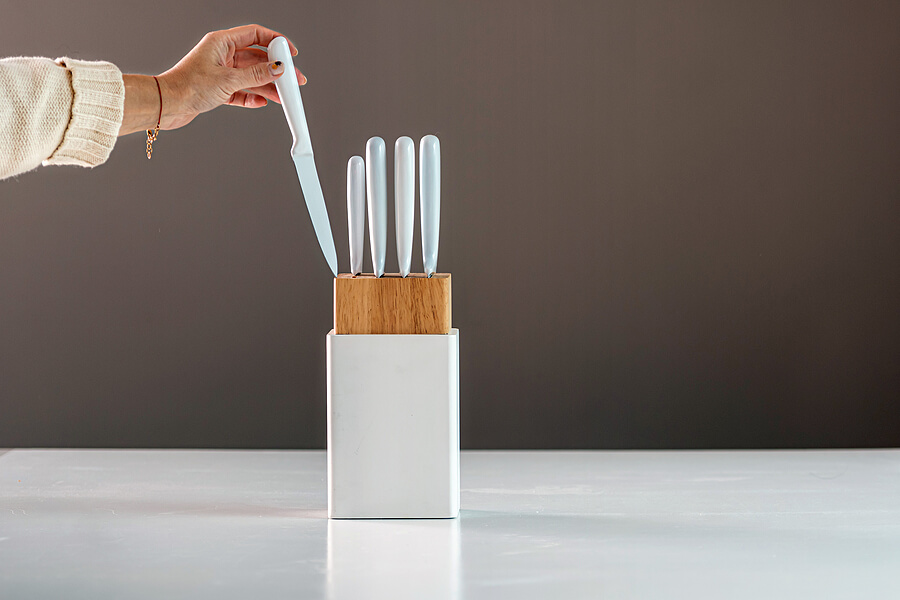Utility knives are a must-have for a variety of jobs. You can rely on a good one to cut drywall, vinyl flooring, carpeting, cardboard, rope, and a host of other materials. Everyone from warehouse workers to artists to home improvement enthusiasts keep a trusty cutting tool like one of these utility knives within reach.

But you’re sure to have questions before you use a utility knife for the first time. Maybe you need new tools for a renovation project and have no idea how to handle a utility knife properly for the best results. Or, you need a reliable blade to cut boxes open and want to avoid slicing too deeply into the cardboard.
Whatever the application, whatever the material, safety measures are crucial to avoid injuring yourself or damaging property. So how can you stay safe while using utility knives?
How to Handle a Utility Knife Safely
Cut Materials on a Steady Surface
Around 30% of all injuries in workplaces involve lacerations, most of which affect the fingers or hands. Common reasons why people cut themselves at work include:
- Working too fast
- Inadequate lighting
- Lack of proper PPE
- Failure to follow proper safety procedures
One potential hazard of overlooking safety procedures and rushing work is cutting on an unstable surface.
For example, you might have a stack of packages to open five minutes before you’re due to finish for the day. You could take the time to carry them to a designated cutting area with stable worktops. Or, you could grab your tool and cut the packages open where you stand.
But that means you’ll either hold packages against you, prop them on the edge of a chair, or sit them on your lap. In any case, it’s too easy to misjudge the cutting angle or pressure and potentially damage yourself, the goods within those packages, or a piece of furniture doubling as a makeshift table. And the package could move suddenly before you even realize.
Take a few extra moments to set up a safe cutting area of your workplace, garage, or wherever you’re based. Position whatever you need to cut on the surface securely, and hold it carefully to stop it from shifting around.
Be Careful When Touching Utility Knife Blades
Resist the temptation to run your finger along the edge of most utility knives. Sure, that can be difficult when you want to feel how sharp your new tool is before you use it. But utility knives, specifically traditional steel knives, can be sharper than you may realize and could cut your finger or hand severely. Even blades made from zirconium oxide (i.e. ceramic) have the ability to cause injuries if handled improperly. They are finger friendly, but they are still blades.
Similarly, take care when handing your utility knife to someone else. Make sure the blade is retracted before you pass it over, and tell them how to use the tool properly if it’s their first time. Smart-retracting utility knives are designed to pull the blade into the handle when it loses contact with the material you’re cutting. It doesn’t get much easier to use than that.
Avoid Distractions While Using Your Utility Knife
Repetition can cause you to totally lose track of what you’re doing and forget that you’re handling a potentially dangerous tool. You could be chatting with your friends or colleagues or glance out the window while cutting. All it takes to injure yourself is a moment of poor concentration. Put a pin in your conversation until the cut is complete.
Only Use Utility Knives for Appropriate Tasks
Utility knives are manufactured to do specific jobs. Different models cater to different users and applications.
It’s vital that you only use a utility knife for its intended purpose—not as a screwdriver or a chisel. Although campers may use pocket knives or utility knives as a last resort for food preparation, kitchen knives are best used for cooking. By using the wrong kind of knife, You could damage the blade, the handle, or both. Or, you may injure yourself if the knife breaks in your hand or creates flying debris.
If in doubt, check with the knife’s manufacturer before purchase to understand what you should and shouldn’t use the tool for.
Conclusion
Utility knives can provide a safe experience when you take basic safety precautions and follow the manufacturer’s instructions. Only use cutting tools from trusted suppliers, and investigate the safest products on the market before your next purchase. It’s also a good idea to check reviews written by people using the knife for the same or a similar purpose as you.
The best utility knives cut materials safely and effectively when used properly. Always ask an expert for advice if you’re not sure how the tool works, to make sure you get maximum bang for your buck.


